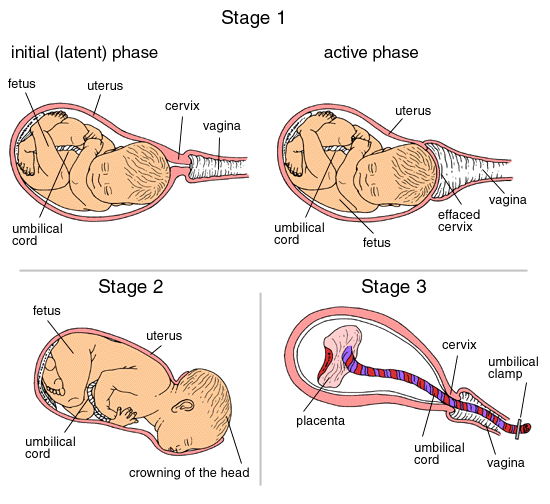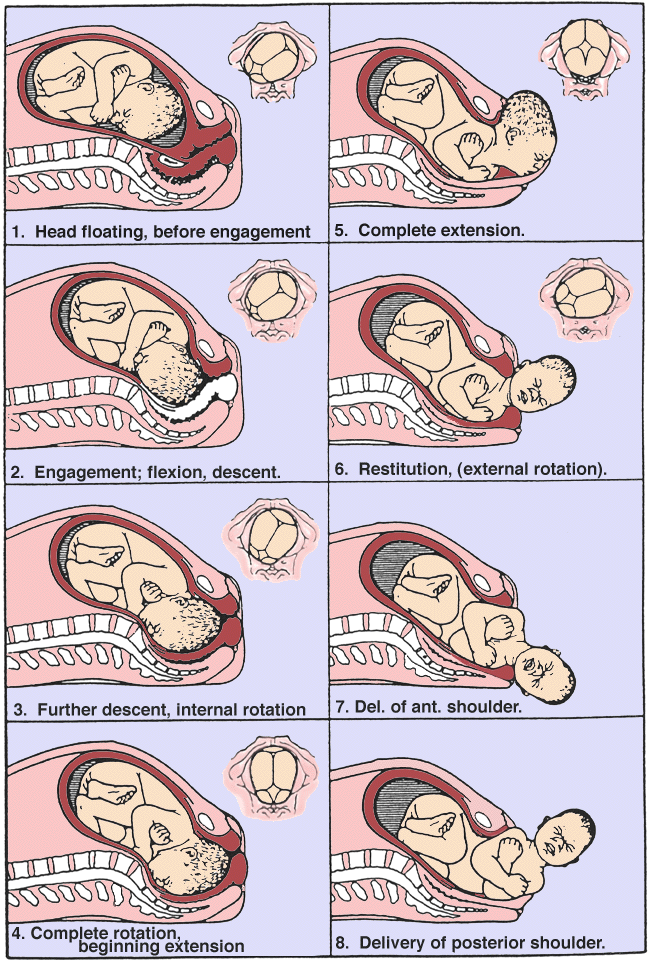
Image Source: Dare Alla Luce Doula and Medchrome.
- Labor is a physiologic process during which the fetus, its associated membranes, the umbilical cord, and the placenta are expelled from the uterus.
- During most of the months of pregnancy, the uterus undergoes periodic episodes of weak and slow rhythmical contractions called Braxton Hicks contractions.
- Contractions become progressively stronger toward the end of pregnancy; that start stretching the cervix and later force the baby through the birth canal, thereby causing parturition.
- This process is called labor, and the strong contractions that result in final parturition are called labor contractions.
Interesting Science Videos
Features of Labor Process
- The uterine contractions during labor begin mainly at the top of the uterine fundus and spread down over the body of the uterus.
- In the early part of labor, the contractions might occur only once every 30 minutes. As labor progresses the contractions finally appear as often as once every 1 to 3 minutes, and the intensity of contraction increases greatly.
- The combined contractions of the uterine and abdominal musculature during delivery of the baby cause a downward force on the fetus of about 25 pounds during each strong contraction.
- In about 95 percent of births, the head is the first part of the baby to be expelled, and in most of the remaining instances, the buttocks are presented first.
- The head acts as a wedge to open the structures of the birth canal as the fetus is forced downward. The first major obstruction to the expulsion of the fetus is the uterine cervix.
Stages of Labor
Image Source: Dare Alla Luce Doula
Obstetricians have divided labor into 3 stages that delineate milestones in a continuous process.
- First stage of labor
- Also known as the period of progressive cervical dilation.
- Lasts until the cervical opening is as large as the head of the fetus
- Usually lasts for 8 to 24 hours in the first pregnancy but often only a few minutes after many pregnancies.
- Divided into a latent phase and an active phase
- The latent phase begins with mild, irregular uterine contractions that soften and shorten the cervix.
- Contractions become progressively more rhythmic and stronger.
- The active phase usually begins at about 3-4 cm of cervical dilation and is characterized by rapid cervical dilation and descent of the presenting fetal part.
- Second stage of labor
- Begins with complete cervical dilatation and ends with the delivery of the fetus
- Once the cervix has dilated fully, the fetal membranes usually rupture and the amniotic fluid is lost suddenly through the vagina.
- Then the fetus’s head moves rapidly into the birth canal, and with additional force from above, it continues to wedge its way through the canal until delivery is effected.
- This is called the second stage of labor, and it may last from as little as 1 minute after many pregnancies to 30 minutes or more in the first pregnancy.
- Third stage of labor
- The third stage is the delivery of the placenta and is the shortest stage.
- For 10 to 45 minutes after the birth of the baby, the uterus continues to contract to a smaller and smaller size.
- This causes a shearing effect between the walls of the uterus and the placenta, thus separating the placenta from its implantation site.
Mechanism of labor
- The exact events leading up to the onset of labor are still not fully understood.
- For the baby to arrive, two things must happen: the muscles in the womb and abdominal wall have to contract and the cervix needs to soften, or ripen, allowing passage of the baby from the womb to the outside world.
- This is brought about by specific movements and hormones.
- The movements during labor, also known as the cardinal movements, involve changes in the position of the fetus’s head during its passage in labor.
- These are described in relation to a vertex presentation.
Image Source: Medchrome
Although labor and delivery occur in a continuous fashion, the cardinal movements are described as the following 7 discrete sequences:
- Engagement
- Descent
- Flexion
- Internal rotation
- Extension
- Restitution and external rotation
- Expulsion
- The hormone oxytocin plays a key role in labor.
- Often called the ‘love hormone’, oxytocin is associated with feelings of bonding and motherhood.
- Oxytocin levels rise at the onset of labor, causing regular contractions of the womb and abdominal muscles.
- Oxytocin-induced contractions become stronger and more frequent without the influence of progesterone and oestrogen, which at high levels prevent labor.
- Oxytocin, along with other hormones, stimulates the ripening of the cervix leading to successive dilation during labor.
- Oxytocin, with the help of the high levels of oestrogen, causes the release of a group of hormones, known as prostaglandins, which may play a role in the ripening of the cervix.
- Levels of relaxin also increase rapidly during labor. This aids the lengthening and softening of the cervix and the softening and expansion of the mother’s lower pelvic region, thereby further aiding the baby’s arrival.
- As birth becomes imminent, the mother’s body releases large amounts of adrenaline and noradrenaline – so-called ‘fight or flight’ hormones.
- A sudden rush of these hormones just before birth causes a surge of energy in the mother and several very strong contractions that help to deliver the baby.
References
- Hall, J. E., & Guyton, A. C. (2011). Guyton and Hall textbook of medical physiology. Philadelphia, PA: Saunders Elsevier.
- https://emedicine.medscape.com/article/260036-overview
- https://www.pregnancybirthbaby.org.au/labour-the-signs-and-stages
- https://wa.kaiserpermanente.org/healthAndWellness/index.jhtml?item=%2Fcommon%2FhealthAndWellness%2Fpregnancy%2Fbirth%2FlaborStages.html
- https://www.babycentre.co.uk/a177/the-stages-of-childbirth
- https://americanpregnancy.org/labor-and-birth/third-stage/
- https://www.yourhormones.info/topical-issues/hormones-of-pregnancy-and-labour/


